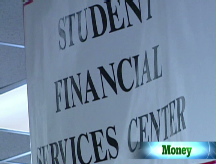Beat the college loan crunch
Lenders are leaving in droves, which could cut off funds for the coming academic year. Here's how to get the money your child needs.
|
|
(Money Magazine) -- For families with children heading off to college, this has been the year from hell. First, a record number of applicants made 2008 the most competitive year ever for college admissions. Then the credit crunch hit the college market in a big way, igniting fears of a drought in financing for all students this fall.
Spurred by dwindling demand for packaged loans from investors and cuts on federal subsidies, more than 100 lenders in the government college loan program have pulled out of the market. Private lenders are leaving the college market too - 27 so far. Those who remain are making it tougher to qualify for loans, while jacking up rates and reducing discounts.
The result: If you're counting on a loan to pay tuition bills this fall, you're probably anxiously holding your breath, waiting to see if you'll be able to borrow what you need at a rate you can afford.
Well, Mom and Dad, you can officially exhale now. You'll be fine, if you just play it right. Unlike the crisis in the mortgage market, where politicians continue to argue about how to help without actually doing much, Uncle Sam in recent weeks has swooped in with a practical damage-control plan for college borrowers.
If there is a shortage of lenders to dole out federal loans, the Department of Education (DOE) will fill the void. In addition, the feds vowed to thaw the market for securitized federal student loans, agreeing to buy the packaged debt if outside investors don't. That provides plenty of incentive for lenders to get back in the game.
Congress has also taken steps to make sure there's plenty of government money for families to borrow, so you don't have to resort to the pricey private-loan market. Federal-loan limits for students have been raised by $2,000 a year, while the rules on parent loans have been changed to make qualifying for and repaying them easier.
Despite the last-minute save from Capitol Hill, navigating the loan market this year will still be challenging. You may need to find a new lender if your current one is out of the business. And given that Washington's final regulations were announced just two weeks before the unofficial June 1 launch of loan season, there is going to be plenty of scrambling by schools, lenders and the DOE to get everything up and running.
"Families may run into some confusion," says Kevin Walker, chief executive officer of SimpleTuition.com, which amalgamates federal and private loan offers from dozens of lenders. "But with a little more time and effort, you will be able to get the money you need." Whew.
This is what you have to do:
It may seem as if there are hundreds of different types of college loans out there. But the options basically boil down to this: You can borrow from the government or a private lender, in your name or your child's. That's it.
Despite the scary stuff in the news lately about how scarce college money will be, loans from the federal government, for both students and parents, will remain plentiful. Private loans, however, are another matter. The real question is, Why would anyone want a private college loan anyway?
True, more and more families have been opting for them - they now account for 20% of all student loans vs. just 4% a decade ago. But their popularity is mostly because of aggressive marketing and what seems like an easier application process (you don't have to fill out the cumbersome Free Application for Federal Student Aid, or FAFSA, to get one) - not because they're a better deal.
Rates on most private college loans are higher than those on government loans (in some cases, twice as high), and they're variable, so your rate may rise in the future. Fees are usually more onerous too (up to 11% of the amount borrowed vs. 2% to 4% for federal loans).
And now it's tougher to qualify for them: Most private lenders these days require students to have a cosigner (hello, Mom and Dad) with a credit score of at least 680 vs. 640 previously. And you'll need 750 or better to land the lowest rates.
The bottom line for most families: Consider a private loan only as a last resort and instead make federal Staffords (for students) and PLUS loans (for parents) your borrowing vehicles of choice.
Before this year, the problem with Stafford Loans was the limited amounts students could borrow - just $3,500 for a freshman, rising to $5,500 by senior year. But as part of their rescue plan this spring, lawmakers upped the ante: Starting this month, freshmen can borrow up to $5,500; sophomores, $6,500; juniors and seniors, $7,500.
You probably can't beat the rate either: 6.8% for an unsubsidized Stafford that all students, regardless of family income, are eligible for; or 6% for the subsidized version that's doled out on the basis of financial need. That's about two percentage points less than the rate on PLUS loans and up to nine points less than private loans.
The major difference between the two is that with an unsubsidized Stafford, the student pays the interest that accrues during college, while the feds pick up the tab with the subsidized version. With either loan, you don't have to start paying until after your child is out of school. And if you don't want Junior overburdened by debt, you can always take over all or part of the payments once he graduates.
Fair warning: You do have to fill out the mind-numbing FAFSA to get a Stafford (or a PLUS loan, for that matter). Don't worry if you missed your college's deadline, usually in mid- to late winter. That early due date only matters if you want to be considered for grants or subsidized loans from the school; you can fill out FAFSA anytime during the academic year to qualify for a loan.
Need help with the form? MyRichUncle.com, a student-loan company, offers step-by-step help online.
If your family needs to borrow more than a Stafford allows, a PLUS loan for parents is probably your next best bet. With a PLUS, you can borrow as much as the school costs. And the fixed rate is a competitive 7.9% if your child's college participates in the federal government's direct-lending program, 8.5% if the school works with third-party lenders (check with the financial aid office).
There is a credit check for a PLUS, but it's cursory - you will be turned down only if you've declared bankruptcy, lost a home through foreclosure in the past five years or are more than 90 days late on bill payments. And Congress just extended the late-payment requirement to 180 days for mortgage payments and medical bills.
The new legislation also eased up on repayment rules that had put a strain on many families. Parents can now defer repaying the loan until after their child graduates. Previously, parents had to start repaying the loan within two months of the money being disbursed.
The maximum rates for Stafford and PLUS loans are set by the government. But lenders may offer lower rates to get your business. For example, MyRichUncle.com will drop the rate on an unsubsidized Stafford by half a point, from 6.8% to 6.3%, once you begin repayment.
Other lenders may absorb fees or lower your rate if, for instance, you agree to have money automatically deducted from a checking account when the time comes to start repaying the loan.
Such deals are harder to find than in years past, experts say, because lenders feeling pinched by the loss of federal subsidies and by the turmoil in the credit markets are trying to hold on to every penny. Compare offers from lenders listed on your school's preferred lender list with what you find at Web sites like SimpleTuition.com and StudentLoanMonkey.com to see who has the best deal.
Also check out the terms on college loans offered by your state. More than two dozen states have loan programs, and the terms are often very competitive, says Kalman Chany, author of "Paying for College Without Going Broke." The rate may be on par with that of Staffords, and as with PLUS loans, you can borrow the full cost of college. Check with your state's loan authority or ask your financial aid office for details.
No matter what lender you decide to go with, chances are you'll be given a choice about whether to pay interest on the loan while your child is in college or defer payments until after graduation, and have the interest that builds up tacked on to the amount you borrowed. Although it's tough to pay the interest at the same time you're paying tuition bills, doing so will sharply reduce your total borrowing costs.
Say your student takes out the maximum Stafford in each of her four years in college. If you pay the interest while she's in school, she'll owe just over $37,000 when she graduates, calculates Marc Stein of StudentLoanMonkey.com. Defer and the bill instead shoots up to $44,500.
And the burden of deferring can be even greater on costlier PLUS and private loans. Just ask the Quirk family of Corry, Pa. Their daughter Amy took out an $18,000 private loan to help pay for her freshman year at Penn State three years ago. The initial 8% rate has jumped as high as 14% (it's 10% now), and the deferred interest has boosted the amount she owes to $28,000 - with 18 months of school still to go.
Parents Rick, 45, a mechanical engineer, and Cheri, 43, a middle school teacher, worry about the debt Amy will be saddled with when she gets out of school. "I feel terrible about it," says Cheri. "We just didn't know any better at the time."
They do now. Since Amy's sophomore year, the Quirks have taken out federal PLUS loans, paying part of the interest along the way - and saving thousands in the long run compared with what they'd owe if they'd stuck with private loans. If the end result of this year's student-loan crisis is that families like the Quirks are driven to seek out cheaper financing options, there may be a silver lining after all.
Are you prepared for a financial emergency?
With a recession and rising inflation, it's more crucial than ever to have a six to 12-month living-expense cushion in cash for an emergency. Don't have it? Drop us a line at makeover@moneymail.com. Include your name, age, city, state, marital status, occupation, how much you have in cash savings and retirement savings. Please send a photo of you (and your spouse, where applicable) too. ![]()



